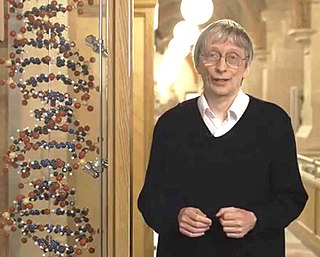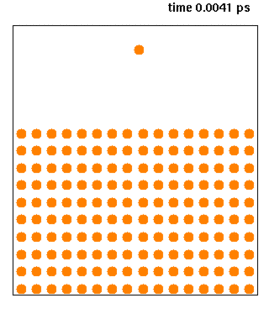Computational chemistry is a branch of chemistry that uses computer simulation to assist in solving chemical problems. It uses methods of theoretical chemistry, incorporated into computer programs, to calculate the structures and properties of molecules, groups of molecules, and solids. It is essential because, apart from relatively recent results concerning the hydrogen molecular ion, the quantum many-body problem cannot be solved analytically, much less in closed form. While computational results normally complement the information obtained by chemical experiments, it can in some cases predict hitherto unobserved chemical phenomena. It is widely used in the design of new drugs and materials.

David Elieser Deutsch is a British physicist at the University of Oxford. He is a Visiting Professor in the Department of Atomic and Laser Physics at the Centre for Quantum Computation (CQC) in the Clarendon Laboratory of the University of Oxford. He pioneered the field of quantum computation by formulating a description for a quantum Turing machine, as well as specifying an algorithm designed to run on a quantum computer. He has also proposed the use of entangled states and Bell's theorem for quantum key distribution and is a proponent of the many-worlds interpretation of quantum mechanics.

Physics is the natural science that studies matter, its fundamental constituents, its motion and behavior through space and time, and the related entities of energy and force. Physics is one of the most fundamental scientific disciplines, with its main goal being to understand how the universe behaves.
The following outline is provided as an overview of and topical guide to physics:

Quantum computing is a type of computation that harnesses the collective properties of quantum states, such as superposition, interference, and entanglement, to perform calculations. The devices that perform quantum computations are known as quantum computers. Though current quantum computers are too small to outperform usual (classical) computers for practical applications, they are believed to be capable of solving certain computational problems, such as integer factorization, substantially faster than classical computers. The study of quantum computing is a subfield of quantum information science.

Quantum information is the information of the state of a quantum system. It is the basic entity of study in quantum information theory, and can be manipulated using quantum information processing techniques. Quantum information refers to both the technical definition in terms of Von Neumann entropy and the general computational term.

A theory of everything, final theory, ultimate theory, unified field theory or master theory is a hypothetical, singular, all-encompassing, coherent theoretical framework of physics that fully explains and links together all physical aspects of the universe. Finding a theory of everything is one of the major unsolved problems in physics. String theory and M-theory have been proposed as theories of everything.

Molecular dynamics (MD) is a computer simulation method for analyzing the physical movements of atoms and molecules. The atoms and molecules are allowed to interact for a fixed period of time, giving a view of the dynamic "evolution" of the system. In the most common version, the trajectories of atoms and molecules are determined by numerically solving Newton's equations of motion for a system of interacting particles, where forces between the particles and their potential energies are often calculated using interatomic potentials or molecular mechanics force fields. The method is applied mostly in chemical physics, materials science, and biophysics.
Simulated reality is the hypothesis that reality could be simulated—for example by quantum computer simulation—to a degree indistinguishable from "true" reality. It could contain conscious minds that may or may not know that they live inside a simulation. This is quite different from the current, technologically achievable concept of virtual reality, which is easily distinguished from the experience of actuality. Simulated reality, by contrast, would be hard or impossible to separate from "true" reality. There has been much debate over this topic, ranging from philosophical discourse to practical applications in computing.
A deterministic system is a conceptual model of the philosophical doctrine of determinism applied to a system for understanding everything that has and will occur in the system, based on the physical outcomes of causality. In a deterministic system, every action, or cause, produces a reaction, or effect, and every reaction, in turn, becomes the cause of subsequent reactions. The totality of these cascading events can theoretically show exactly how the system will exist at any moment in time.
Digital physics is a speculative idea that the universe can be conceived of as a vast, digital computation device, or as the output of a deterministic or probabilistic computer program. The hypothesis that the universe is a digital computer was proposed by Konrad Zuse in his book Rechnender Raum. The term digital physics was employed by Edward Fredkin in 1978, who later came to prefer the term digital philosophy. Fredkin encouraged the creation of a digital physics group at what was then MIT's Laboratory for Computer Science, with Tommaso Toffoli and Norman Margolus as primary figures.

Calculating Space is Konrad Zuse's 1969 book on automata theory. He proposed that all processes in the universe are computational. This view is known today as the simulation hypothesis, digital philosophy, digital physics or pancomputationalism. Zuse proposed that the universe is being computed by some sort of cellular automaton or other discrete computing machinery, challenging the long-held view that some physical laws are continuous by nature. He focused on cellular automata as a possible substrate of the computation, and pointed out that the classical notions of entropy and its growth do not make sense in deterministically computed universes. Zuse's thesis was later expanded by German computer scientist Jürgen Schmidhuber in his book Algorithmic Theories of Everything.

Seth Lloyd is a professor of mechanical engineering and physics at the Massachusetts Institute of Technology.
The limits of computation are governed by a number of different factors. In particular, there are several physical and practical limits to the amount of computation or data storage that can be performed with a given amount of mass, volume, or energy.
The simulation hypothesis is a proposal regarding the nature of existence which posits that all of existence is an artificial simulation, such as a computer simulation. Some versions rely on the development of a simulated reality, a proposed technology that would be able to convince its inhabitants that the simulation was "real".

Physics is a scientific discipline that seeks to construct and experimentally test theories of the physical universe. These theories vary in their scope and can be organized into several distinct branches, which are outlined in this article.
Paola Zizzi is an Italian theoretical physicist who is most notable for her work in the field of loop quantum gravity, which regards the universe as a kind of super computer. She proposed that the universe has the computational complexity sufficient for the emergence of consciousness in the period known as the cosmic inflation in her paper titled Emergent Consciousness, which references Roger Penrose's theory of orchestrated objective reduction.

Decoding Reality: The Universe as Quantum Information is a popular science book by Vlatko Vedral published by Oxford University Press in 2010. Vedral examines information theory and proposes information as the most fundamental building block of reality. He argues what a useful framework this is for viewing all natural and physical phenomena. In building out this framework the books touches upon the origin of information, the idea of entropy, the roots of this thinking in thermodynamics, the replication of DNA, development of social networks, quantum behaviour at the micro and macro level, and the very role of indeterminism in the universe. The book finishes by considering the answer to the ultimate question: where did all of the information in the Universe come from? The ideas address concepts related to the nature of particles, time, determinism, and of reality itself.
Norman H. Margolus is a Canadian-American physicist and computer scientist, known for his work on cellular automata and reversible computing. He is a research affiliate with the Computer Science and Artificial Intelligence Laboratory at the Massachusetts Institute of Technology.
Constructor theory is a proposal for a new mode of explanation in fundamental physics in the language of ergodic theory, first sketched out by David Deutsch, a quantum physicist at the University of Oxford, in 2012. Constructor theory expresses physical laws exclusively in terms of which physical transformations, or tasks, are possible versus which are impossible, and why. By allowing such counterfactual statements into fundamental physics, it allows new physical laws to be expressed, such as the constructor theory of information.










